Customer Benefit Packages and Value Chains
VerifiedAdded on 2023/04/11
|11
|2753
|440
AI Summary
This study material explores the concept of customer benefit packages and value chains. It describes, compares, and contrasts primary customer benefit packages for McDonald's and H&R Block. It also compares and contrasts the value chain design and structure of these two organizations. The advantages and disadvantages of their value chain design and structure are outlined. The subject of this study material is operations management.
Contribute Materials
Your contribution can guide someone’s learning journey. Share your
documents today.
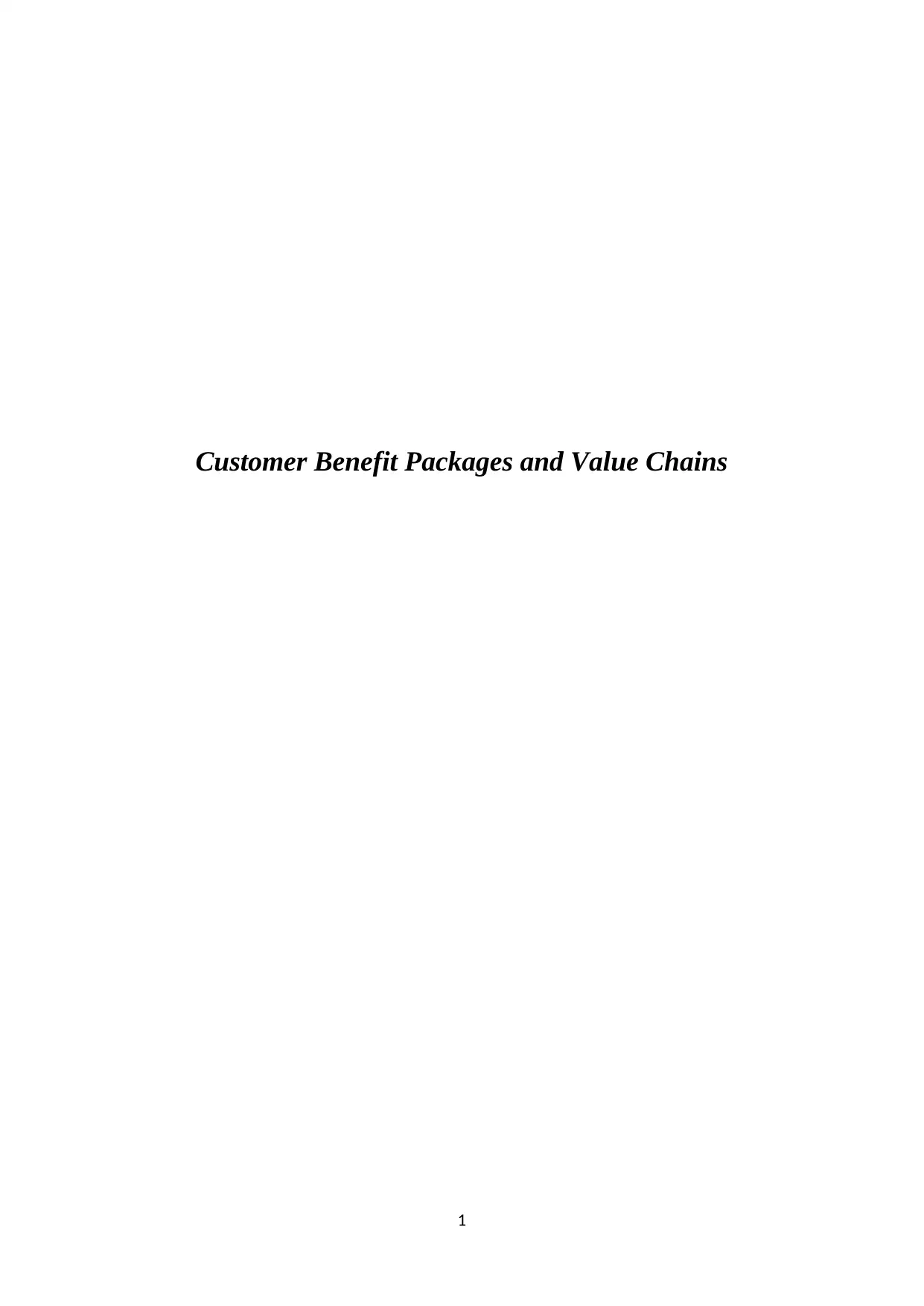
Customer Benefit Packages and Value Chains
1
1
Secure Best Marks with AI Grader
Need help grading? Try our AI Grader for instant feedback on your assignments.
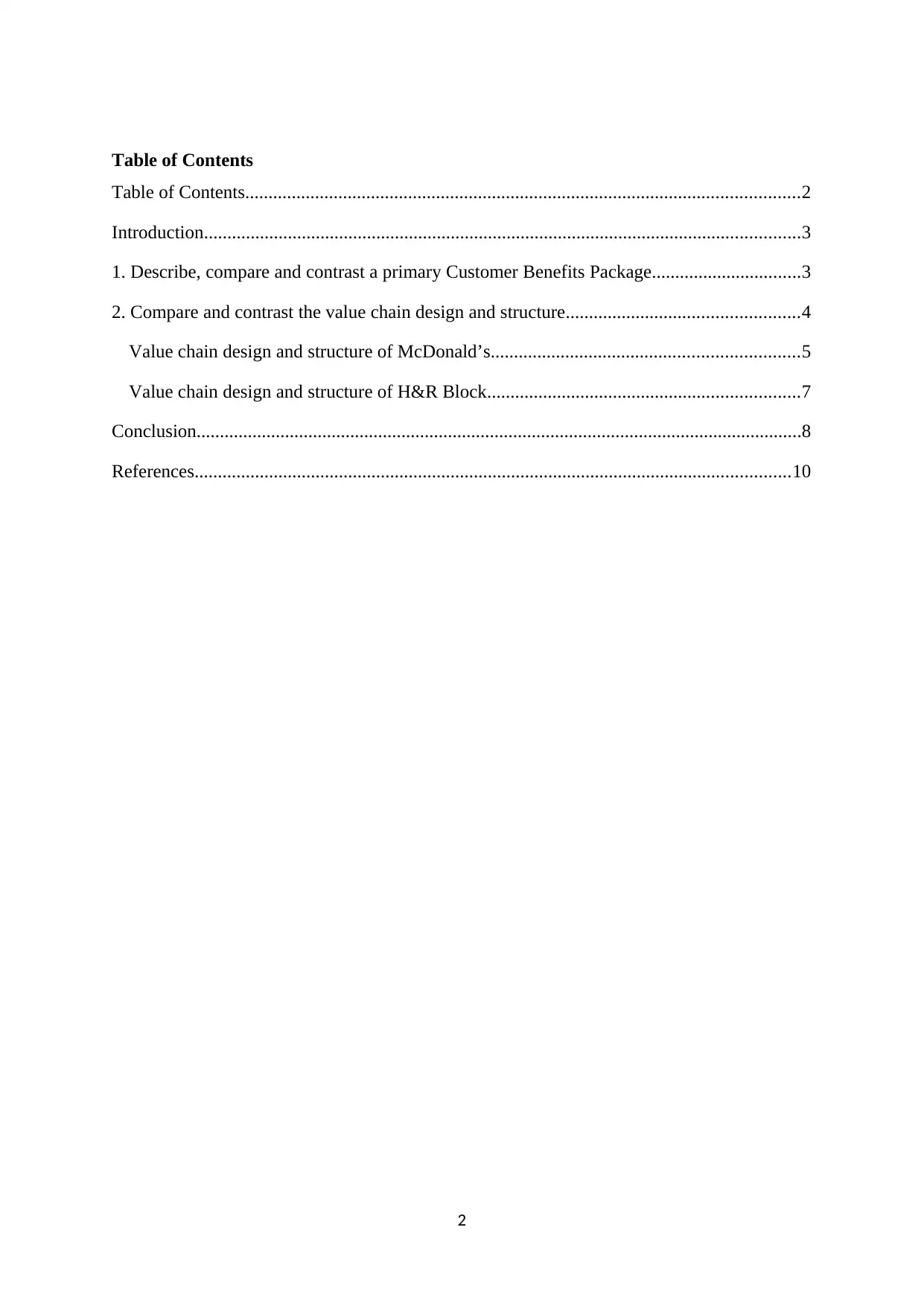
Table of Contents
Table of Contents.......................................................................................................................2
Introduction................................................................................................................................3
1. Describe, compare and contrast a primary Customer Benefits Package................................3
2. Compare and contrast the value chain design and structure..................................................4
Value chain design and structure of McDonald’s..................................................................5
Value chain design and structure of H&R Block...................................................................7
Conclusion..................................................................................................................................8
References................................................................................................................................10
2
Table of Contents.......................................................................................................................2
Introduction................................................................................................................................3
1. Describe, compare and contrast a primary Customer Benefits Package................................3
2. Compare and contrast the value chain design and structure..................................................4
Value chain design and structure of McDonald’s..................................................................5
Value chain design and structure of H&R Block...................................................................7
Conclusion..................................................................................................................................8
References................................................................................................................................10
2
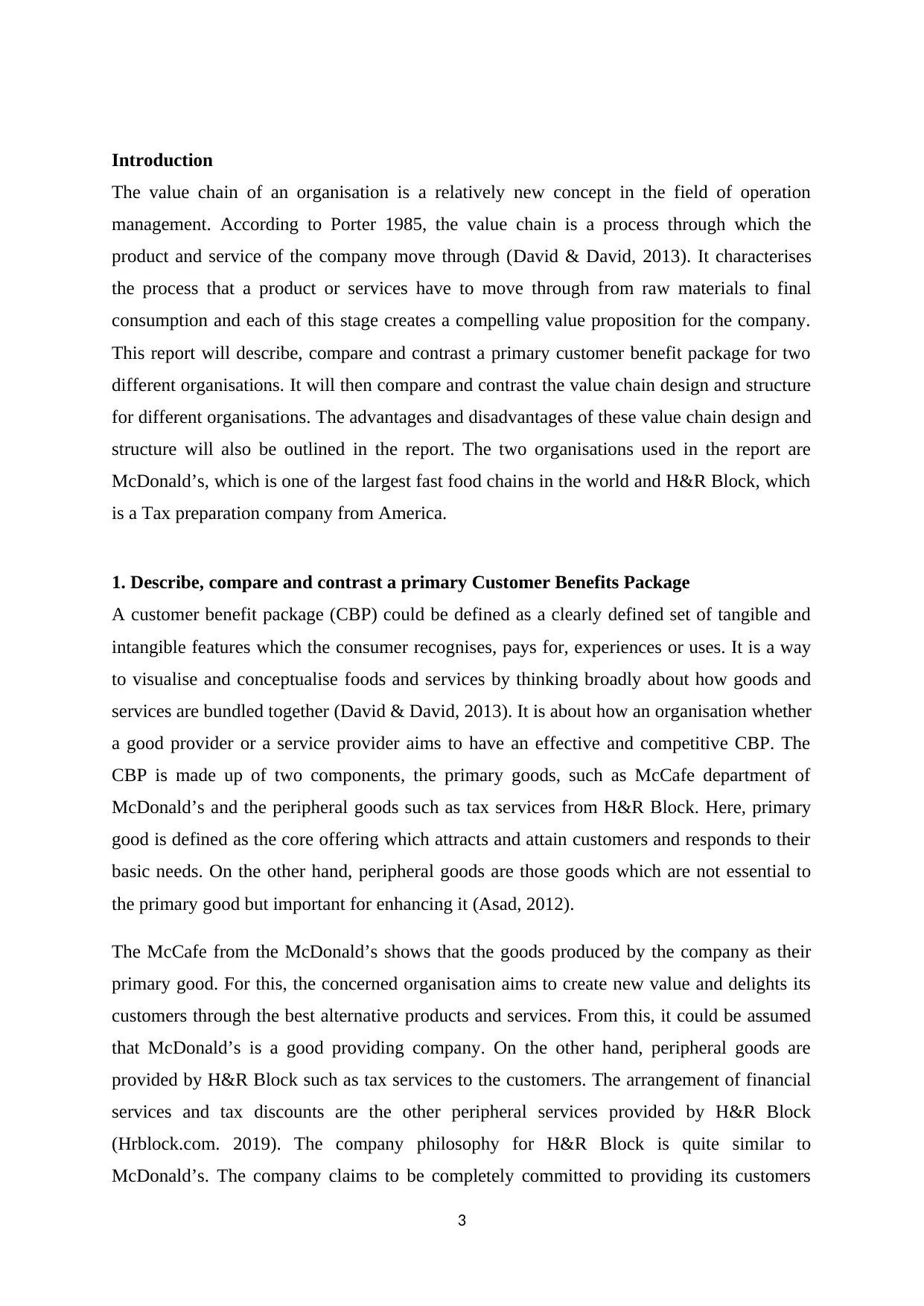
Introduction
The value chain of an organisation is a relatively new concept in the field of operation
management. According to Porter 1985, the value chain is a process through which the
product and service of the company move through (David & David, 2013). It characterises
the process that a product or services have to move through from raw materials to final
consumption and each of this stage creates a compelling value proposition for the company.
This report will describe, compare and contrast a primary customer benefit package for two
different organisations. It will then compare and contrast the value chain design and structure
for different organisations. The advantages and disadvantages of these value chain design and
structure will also be outlined in the report. The two organisations used in the report are
McDonald’s, which is one of the largest fast food chains in the world and H&R Block, which
is a Tax preparation company from America.
1. Describe, compare and contrast a primary Customer Benefits Package
A customer benefit package (CBP) could be defined as a clearly defined set of tangible and
intangible features which the consumer recognises, pays for, experiences or uses. It is a way
to visualise and conceptualise foods and services by thinking broadly about how goods and
services are bundled together (David & David, 2013). It is about how an organisation whether
a good provider or a service provider aims to have an effective and competitive CBP. The
CBP is made up of two components, the primary goods, such as McCafe department of
McDonald’s and the peripheral goods such as tax services from H&R Block. Here, primary
good is defined as the core offering which attracts and attain customers and responds to their
basic needs. On the other hand, peripheral goods are those goods which are not essential to
the primary good but important for enhancing it (Asad, 2012).
The McCafe from the McDonald’s shows that the goods produced by the company as their
primary good. For this, the concerned organisation aims to create new value and delights its
customers through the best alternative products and services. From this, it could be assumed
that McDonald’s is a good providing company. On the other hand, peripheral goods are
provided by H&R Block such as tax services to the customers. The arrangement of financial
services and tax discounts are the other peripheral services provided by H&R Block
(Hrblock.com. 2019). The company philosophy for H&R Block is quite similar to
McDonald’s. The company claims to be completely committed to providing its customers
3
The value chain of an organisation is a relatively new concept in the field of operation
management. According to Porter 1985, the value chain is a process through which the
product and service of the company move through (David & David, 2013). It characterises
the process that a product or services have to move through from raw materials to final
consumption and each of this stage creates a compelling value proposition for the company.
This report will describe, compare and contrast a primary customer benefit package for two
different organisations. It will then compare and contrast the value chain design and structure
for different organisations. The advantages and disadvantages of these value chain design and
structure will also be outlined in the report. The two organisations used in the report are
McDonald’s, which is one of the largest fast food chains in the world and H&R Block, which
is a Tax preparation company from America.
1. Describe, compare and contrast a primary Customer Benefits Package
A customer benefit package (CBP) could be defined as a clearly defined set of tangible and
intangible features which the consumer recognises, pays for, experiences or uses. It is a way
to visualise and conceptualise foods and services by thinking broadly about how goods and
services are bundled together (David & David, 2013). It is about how an organisation whether
a good provider or a service provider aims to have an effective and competitive CBP. The
CBP is made up of two components, the primary goods, such as McCafe department of
McDonald’s and the peripheral goods such as tax services from H&R Block. Here, primary
good is defined as the core offering which attracts and attain customers and responds to their
basic needs. On the other hand, peripheral goods are those goods which are not essential to
the primary good but important for enhancing it (Asad, 2012).
The McCafe from the McDonald’s shows that the goods produced by the company as their
primary good. For this, the concerned organisation aims to create new value and delights its
customers through the best alternative products and services. From this, it could be assumed
that McDonald’s is a good providing company. On the other hand, peripheral goods are
provided by H&R Block such as tax services to the customers. The arrangement of financial
services and tax discounts are the other peripheral services provided by H&R Block
(Hrblock.com. 2019). The company philosophy for H&R Block is quite similar to
McDonald’s. The company claims to be completely committed to providing its customers
3
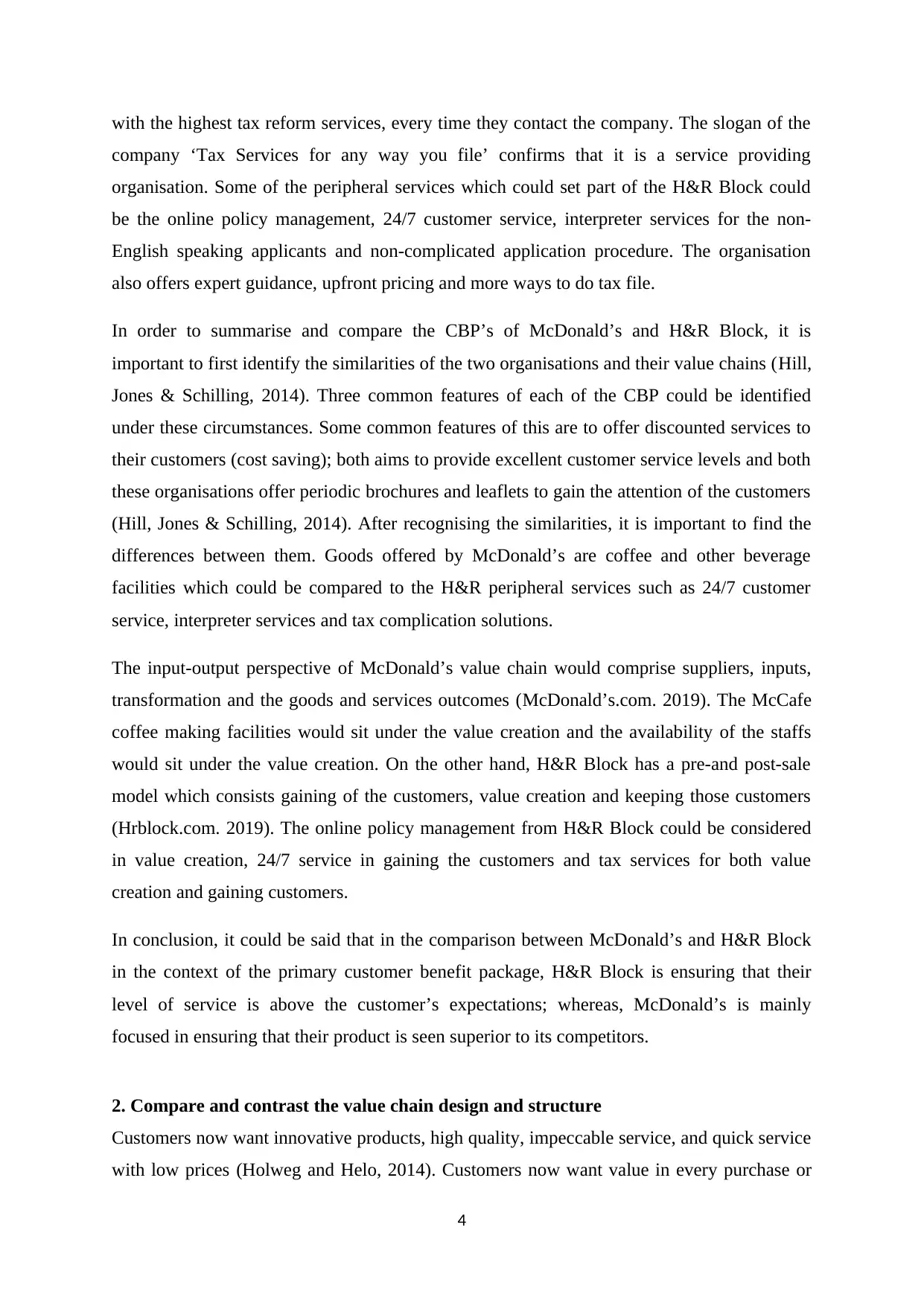
with the highest tax reform services, every time they contact the company. The slogan of the
company ‘Tax Services for any way you file’ confirms that it is a service providing
organisation. Some of the peripheral services which could set part of the H&R Block could
be the online policy management, 24/7 customer service, interpreter services for the non-
English speaking applicants and non-complicated application procedure. The organisation
also offers expert guidance, upfront pricing and more ways to do tax file.
In order to summarise and compare the CBP’s of McDonald’s and H&R Block, it is
important to first identify the similarities of the two organisations and their value chains (Hill,
Jones & Schilling, 2014). Three common features of each of the CBP could be identified
under these circumstances. Some common features of this are to offer discounted services to
their customers (cost saving); both aims to provide excellent customer service levels and both
these organisations offer periodic brochures and leaflets to gain the attention of the customers
(Hill, Jones & Schilling, 2014). After recognising the similarities, it is important to find the
differences between them. Goods offered by McDonald’s are coffee and other beverage
facilities which could be compared to the H&R peripheral services such as 24/7 customer
service, interpreter services and tax complication solutions.
The input-output perspective of McDonald’s value chain would comprise suppliers, inputs,
transformation and the goods and services outcomes (McDonald’s.com. 2019). The McCafe
coffee making facilities would sit under the value creation and the availability of the staffs
would sit under the value creation. On the other hand, H&R Block has a pre-and post-sale
model which consists gaining of the customers, value creation and keeping those customers
(Hrblock.com. 2019). The online policy management from H&R Block could be considered
in value creation, 24/7 service in gaining the customers and tax services for both value
creation and gaining customers.
In conclusion, it could be said that in the comparison between McDonald’s and H&R Block
in the context of the primary customer benefit package, H&R Block is ensuring that their
level of service is above the customer’s expectations; whereas, McDonald’s is mainly
focused in ensuring that their product is seen superior to its competitors.
2. Compare and contrast the value chain design and structure
Customers now want innovative products, high quality, impeccable service, and quick service
with low prices (Holweg and Helo, 2014). Customers now want value in every purchase or
4
company ‘Tax Services for any way you file’ confirms that it is a service providing
organisation. Some of the peripheral services which could set part of the H&R Block could
be the online policy management, 24/7 customer service, interpreter services for the non-
English speaking applicants and non-complicated application procedure. The organisation
also offers expert guidance, upfront pricing and more ways to do tax file.
In order to summarise and compare the CBP’s of McDonald’s and H&R Block, it is
important to first identify the similarities of the two organisations and their value chains (Hill,
Jones & Schilling, 2014). Three common features of each of the CBP could be identified
under these circumstances. Some common features of this are to offer discounted services to
their customers (cost saving); both aims to provide excellent customer service levels and both
these organisations offer periodic brochures and leaflets to gain the attention of the customers
(Hill, Jones & Schilling, 2014). After recognising the similarities, it is important to find the
differences between them. Goods offered by McDonald’s are coffee and other beverage
facilities which could be compared to the H&R peripheral services such as 24/7 customer
service, interpreter services and tax complication solutions.
The input-output perspective of McDonald’s value chain would comprise suppliers, inputs,
transformation and the goods and services outcomes (McDonald’s.com. 2019). The McCafe
coffee making facilities would sit under the value creation and the availability of the staffs
would sit under the value creation. On the other hand, H&R Block has a pre-and post-sale
model which consists gaining of the customers, value creation and keeping those customers
(Hrblock.com. 2019). The online policy management from H&R Block could be considered
in value creation, 24/7 service in gaining the customers and tax services for both value
creation and gaining customers.
In conclusion, it could be said that in the comparison between McDonald’s and H&R Block
in the context of the primary customer benefit package, H&R Block is ensuring that their
level of service is above the customer’s expectations; whereas, McDonald’s is mainly
focused in ensuring that their product is seen superior to its competitors.
2. Compare and contrast the value chain design and structure
Customers now want innovative products, high quality, impeccable service, and quick service
with low prices (Holweg and Helo, 2014). Customers now want value in every purchase or
4
Secure Best Marks with AI Grader
Need help grading? Try our AI Grader for instant feedback on your assignments.
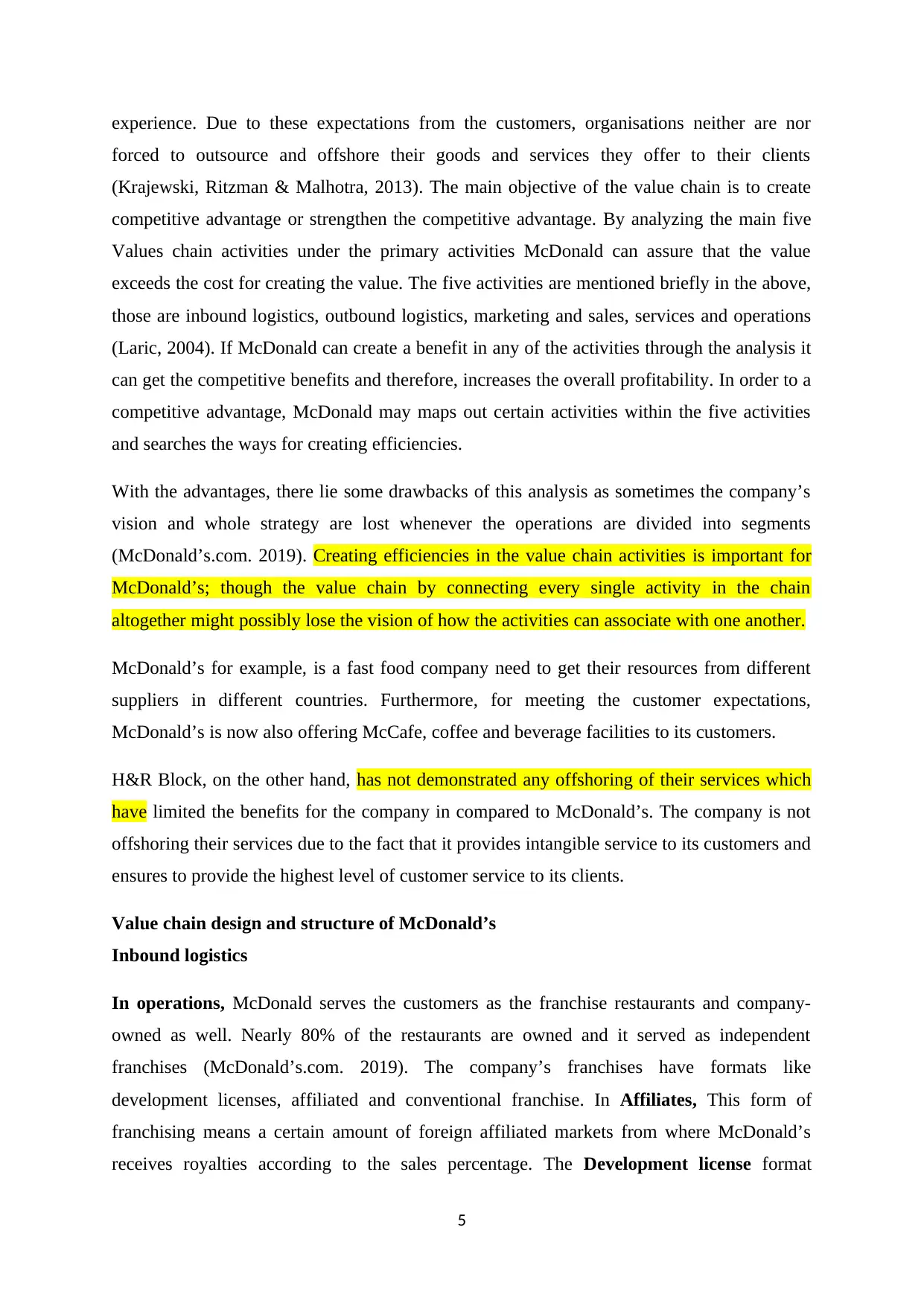
experience. Due to these expectations from the customers, organisations neither are nor
forced to outsource and offshore their goods and services they offer to their clients
(Krajewski, Ritzman & Malhotra, 2013). The main objective of the value chain is to create
competitive advantage or strengthen the competitive advantage. By analyzing the main five
Values chain activities under the primary activities McDonald can assure that the value
exceeds the cost for creating the value. The five activities are mentioned briefly in the above,
those are inbound logistics, outbound logistics, marketing and sales, services and operations
(Laric, 2004). If McDonald can create a benefit in any of the activities through the analysis it
can get the competitive benefits and therefore, increases the overall profitability. In order to a
competitive advantage, McDonald may maps out certain activities within the five activities
and searches the ways for creating efficiencies.
With the advantages, there lie some drawbacks of this analysis as sometimes the company’s
vision and whole strategy are lost whenever the operations are divided into segments
(McDonald’s.com. 2019). Creating efficiencies in the value chain activities is important for
McDonald’s; though the value chain by connecting every single activity in the chain
altogether might possibly lose the vision of how the activities can associate with one another.
McDonald’s for example, is a fast food company need to get their resources from different
suppliers in different countries. Furthermore, for meeting the customer expectations,
McDonald’s is now also offering McCafe, coffee and beverage facilities to its customers.
H&R Block, on the other hand, has not demonstrated any offshoring of their services which
have limited the benefits for the company in compared to McDonald’s. The company is not
offshoring their services due to the fact that it provides intangible service to its customers and
ensures to provide the highest level of customer service to its clients.
Value chain design and structure of McDonald’s
Inbound logistics
In operations, McDonald serves the customers as the franchise restaurants and company-
owned as well. Nearly 80% of the restaurants are owned and it served as independent
franchises (McDonald’s.com. 2019). The company’s franchises have formats like
development licenses, affiliated and conventional franchise. In Affiliates, This form of
franchising means a certain amount of foreign affiliated markets from where McDonald’s
receives royalties according to the sales percentage. The Development license format
5
forced to outsource and offshore their goods and services they offer to their clients
(Krajewski, Ritzman & Malhotra, 2013). The main objective of the value chain is to create
competitive advantage or strengthen the competitive advantage. By analyzing the main five
Values chain activities under the primary activities McDonald can assure that the value
exceeds the cost for creating the value. The five activities are mentioned briefly in the above,
those are inbound logistics, outbound logistics, marketing and sales, services and operations
(Laric, 2004). If McDonald can create a benefit in any of the activities through the analysis it
can get the competitive benefits and therefore, increases the overall profitability. In order to a
competitive advantage, McDonald may maps out certain activities within the five activities
and searches the ways for creating efficiencies.
With the advantages, there lie some drawbacks of this analysis as sometimes the company’s
vision and whole strategy are lost whenever the operations are divided into segments
(McDonald’s.com. 2019). Creating efficiencies in the value chain activities is important for
McDonald’s; though the value chain by connecting every single activity in the chain
altogether might possibly lose the vision of how the activities can associate with one another.
McDonald’s for example, is a fast food company need to get their resources from different
suppliers in different countries. Furthermore, for meeting the customer expectations,
McDonald’s is now also offering McCafe, coffee and beverage facilities to its customers.
H&R Block, on the other hand, has not demonstrated any offshoring of their services which
have limited the benefits for the company in compared to McDonald’s. The company is not
offshoring their services due to the fact that it provides intangible service to its customers and
ensures to provide the highest level of customer service to its clients.
Value chain design and structure of McDonald’s
Inbound logistics
In operations, McDonald serves the customers as the franchise restaurants and company-
owned as well. Nearly 80% of the restaurants are owned and it served as independent
franchises (McDonald’s.com. 2019). The company’s franchises have formats like
development licenses, affiliated and conventional franchise. In Affiliates, This form of
franchising means a certain amount of foreign affiliated markets from where McDonald’s
receives royalties according to the sales percentage. The Development license format
5
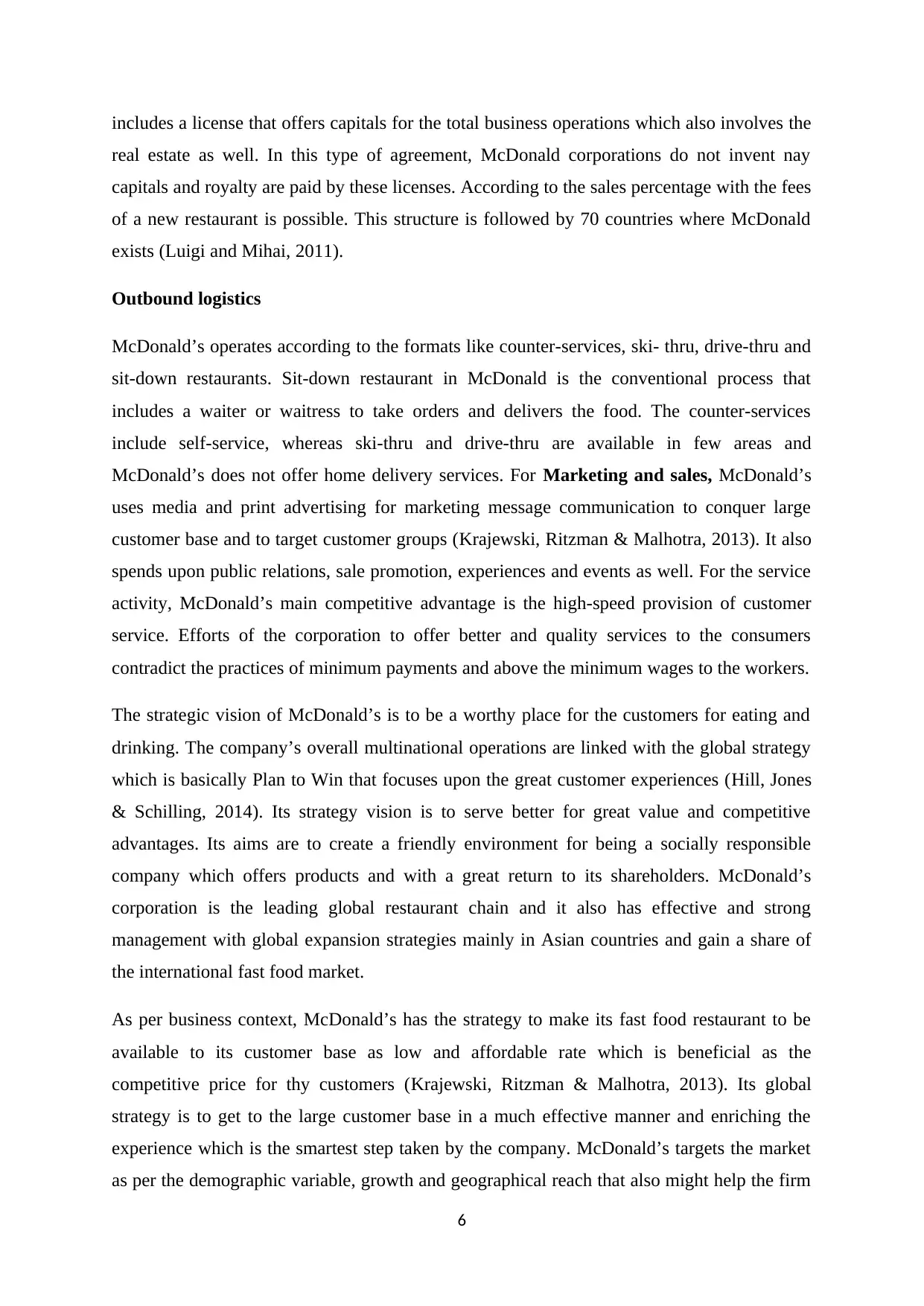
includes a license that offers capitals for the total business operations which also involves the
real estate as well. In this type of agreement, McDonald corporations do not invent nay
capitals and royalty are paid by these licenses. According to the sales percentage with the fees
of a new restaurant is possible. This structure is followed by 70 countries where McDonald
exists (Luigi and Mihai, 2011).
Outbound logistics
McDonald’s operates according to the formats like counter-services, ski- thru, drive-thru and
sit-down restaurants. Sit-down restaurant in McDonald is the conventional process that
includes a waiter or waitress to take orders and delivers the food. The counter-services
include self-service, whereas ski-thru and drive-thru are available in few areas and
McDonald’s does not offer home delivery services. For Marketing and sales, McDonald’s
uses media and print advertising for marketing message communication to conquer large
customer base and to target customer groups (Krajewski, Ritzman & Malhotra, 2013). It also
spends upon public relations, sale promotion, experiences and events as well. For the service
activity, McDonald’s main competitive advantage is the high-speed provision of customer
service. Efforts of the corporation to offer better and quality services to the consumers
contradict the practices of minimum payments and above the minimum wages to the workers.
The strategic vision of McDonald’s is to be a worthy place for the customers for eating and
drinking. The company’s overall multinational operations are linked with the global strategy
which is basically Plan to Win that focuses upon the great customer experiences (Hill, Jones
& Schilling, 2014). Its strategy vision is to serve better for great value and competitive
advantages. Its aims are to create a friendly environment for being a socially responsible
company which offers products and with a great return to its shareholders. McDonald’s
corporation is the leading global restaurant chain and it also has effective and strong
management with global expansion strategies mainly in Asian countries and gain a share of
the international fast food market.
As per business context, McDonald’s has the strategy to make its fast food restaurant to be
available to its customer base as low and affordable rate which is beneficial as the
competitive price for thy customers (Krajewski, Ritzman & Malhotra, 2013). Its global
strategy is to get to the large customer base in a much effective manner and enriching the
experience which is the smartest step taken by the company. McDonald’s targets the market
as per the demographic variable, growth and geographical reach that also might help the firm
6
real estate as well. In this type of agreement, McDonald corporations do not invent nay
capitals and royalty are paid by these licenses. According to the sales percentage with the fees
of a new restaurant is possible. This structure is followed by 70 countries where McDonald
exists (Luigi and Mihai, 2011).
Outbound logistics
McDonald’s operates according to the formats like counter-services, ski- thru, drive-thru and
sit-down restaurants. Sit-down restaurant in McDonald is the conventional process that
includes a waiter or waitress to take orders and delivers the food. The counter-services
include self-service, whereas ski-thru and drive-thru are available in few areas and
McDonald’s does not offer home delivery services. For Marketing and sales, McDonald’s
uses media and print advertising for marketing message communication to conquer large
customer base and to target customer groups (Krajewski, Ritzman & Malhotra, 2013). It also
spends upon public relations, sale promotion, experiences and events as well. For the service
activity, McDonald’s main competitive advantage is the high-speed provision of customer
service. Efforts of the corporation to offer better and quality services to the consumers
contradict the practices of minimum payments and above the minimum wages to the workers.
The strategic vision of McDonald’s is to be a worthy place for the customers for eating and
drinking. The company’s overall multinational operations are linked with the global strategy
which is basically Plan to Win that focuses upon the great customer experiences (Hill, Jones
& Schilling, 2014). Its strategy vision is to serve better for great value and competitive
advantages. Its aims are to create a friendly environment for being a socially responsible
company which offers products and with a great return to its shareholders. McDonald’s
corporation is the leading global restaurant chain and it also has effective and strong
management with global expansion strategies mainly in Asian countries and gain a share of
the international fast food market.
As per business context, McDonald’s has the strategy to make its fast food restaurant to be
available to its customer base as low and affordable rate which is beneficial as the
competitive price for thy customers (Krajewski, Ritzman & Malhotra, 2013). Its global
strategy is to get to the large customer base in a much effective manner and enriching the
experience which is the smartest step taken by the company. McDonald’s targets the market
as per the demographic variable, growth and geographical reach that also might help the firm
6
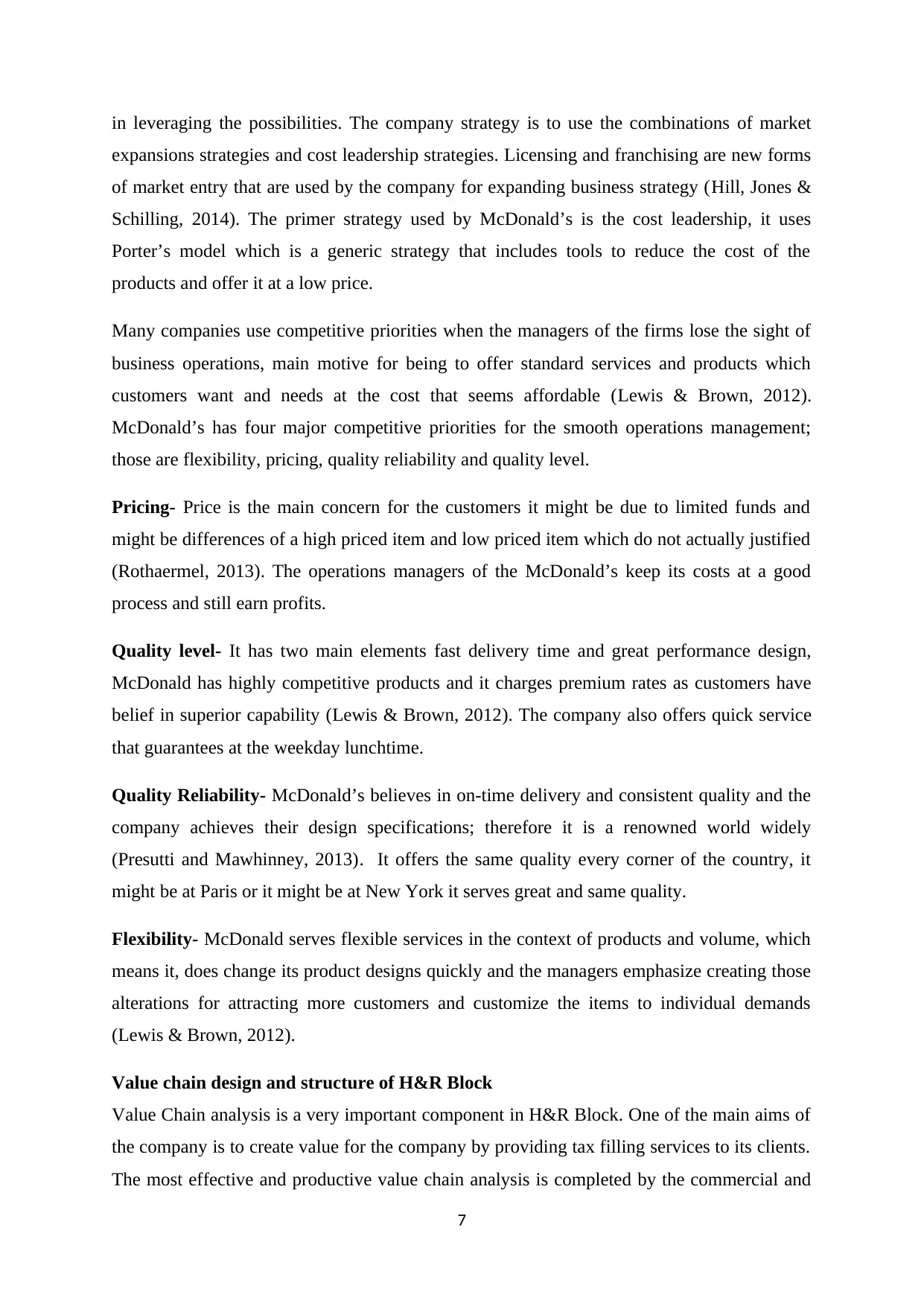
in leveraging the possibilities. The company strategy is to use the combinations of market
expansions strategies and cost leadership strategies. Licensing and franchising are new forms
of market entry that are used by the company for expanding business strategy (Hill, Jones &
Schilling, 2014). The primer strategy used by McDonald’s is the cost leadership, it uses
Porter’s model which is a generic strategy that includes tools to reduce the cost of the
products and offer it at a low price.
Many companies use competitive priorities when the managers of the firms lose the sight of
business operations, main motive for being to offer standard services and products which
customers want and needs at the cost that seems affordable (Lewis & Brown, 2012).
McDonald’s has four major competitive priorities for the smooth operations management;
those are flexibility, pricing, quality reliability and quality level.
Pricing- Price is the main concern for the customers it might be due to limited funds and
might be differences of a high priced item and low priced item which do not actually justified
(Rothaermel, 2013). The operations managers of the McDonald’s keep its costs at a good
process and still earn profits.
Quality level- It has two main elements fast delivery time and great performance design,
McDonald has highly competitive products and it charges premium rates as customers have
belief in superior capability (Lewis & Brown, 2012). The company also offers quick service
that guarantees at the weekday lunchtime.
Quality Reliability- McDonald’s believes in on-time delivery and consistent quality and the
company achieves their design specifications; therefore it is a renowned world widely
(Presutti and Mawhinney, 2013). It offers the same quality every corner of the country, it
might be at Paris or it might be at New York it serves great and same quality.
Flexibility- McDonald serves flexible services in the context of products and volume, which
means it, does change its product designs quickly and the managers emphasize creating those
alterations for attracting more customers and customize the items to individual demands
(Lewis & Brown, 2012).
Value chain design and structure of H&R Block
Value Chain analysis is a very important component in H&R Block. One of the main aims of
the company is to create value for the company by providing tax filling services to its clients.
The most effective and productive value chain analysis is completed by the commercial and
7
expansions strategies and cost leadership strategies. Licensing and franchising are new forms
of market entry that are used by the company for expanding business strategy (Hill, Jones &
Schilling, 2014). The primer strategy used by McDonald’s is the cost leadership, it uses
Porter’s model which is a generic strategy that includes tools to reduce the cost of the
products and offer it at a low price.
Many companies use competitive priorities when the managers of the firms lose the sight of
business operations, main motive for being to offer standard services and products which
customers want and needs at the cost that seems affordable (Lewis & Brown, 2012).
McDonald’s has four major competitive priorities for the smooth operations management;
those are flexibility, pricing, quality reliability and quality level.
Pricing- Price is the main concern for the customers it might be due to limited funds and
might be differences of a high priced item and low priced item which do not actually justified
(Rothaermel, 2013). The operations managers of the McDonald’s keep its costs at a good
process and still earn profits.
Quality level- It has two main elements fast delivery time and great performance design,
McDonald has highly competitive products and it charges premium rates as customers have
belief in superior capability (Lewis & Brown, 2012). The company also offers quick service
that guarantees at the weekday lunchtime.
Quality Reliability- McDonald’s believes in on-time delivery and consistent quality and the
company achieves their design specifications; therefore it is a renowned world widely
(Presutti and Mawhinney, 2013). It offers the same quality every corner of the country, it
might be at Paris or it might be at New York it serves great and same quality.
Flexibility- McDonald serves flexible services in the context of products and volume, which
means it, does change its product designs quickly and the managers emphasize creating those
alterations for attracting more customers and customize the items to individual demands
(Lewis & Brown, 2012).
Value chain design and structure of H&R Block
Value Chain analysis is a very important component in H&R Block. One of the main aims of
the company is to create value for the company by providing tax filling services to its clients.
The most effective and productive value chain analysis is completed by the commercial and
7
Paraphrase This Document
Need a fresh take? Get an instant paraphrase of this document with our AI Paraphraser
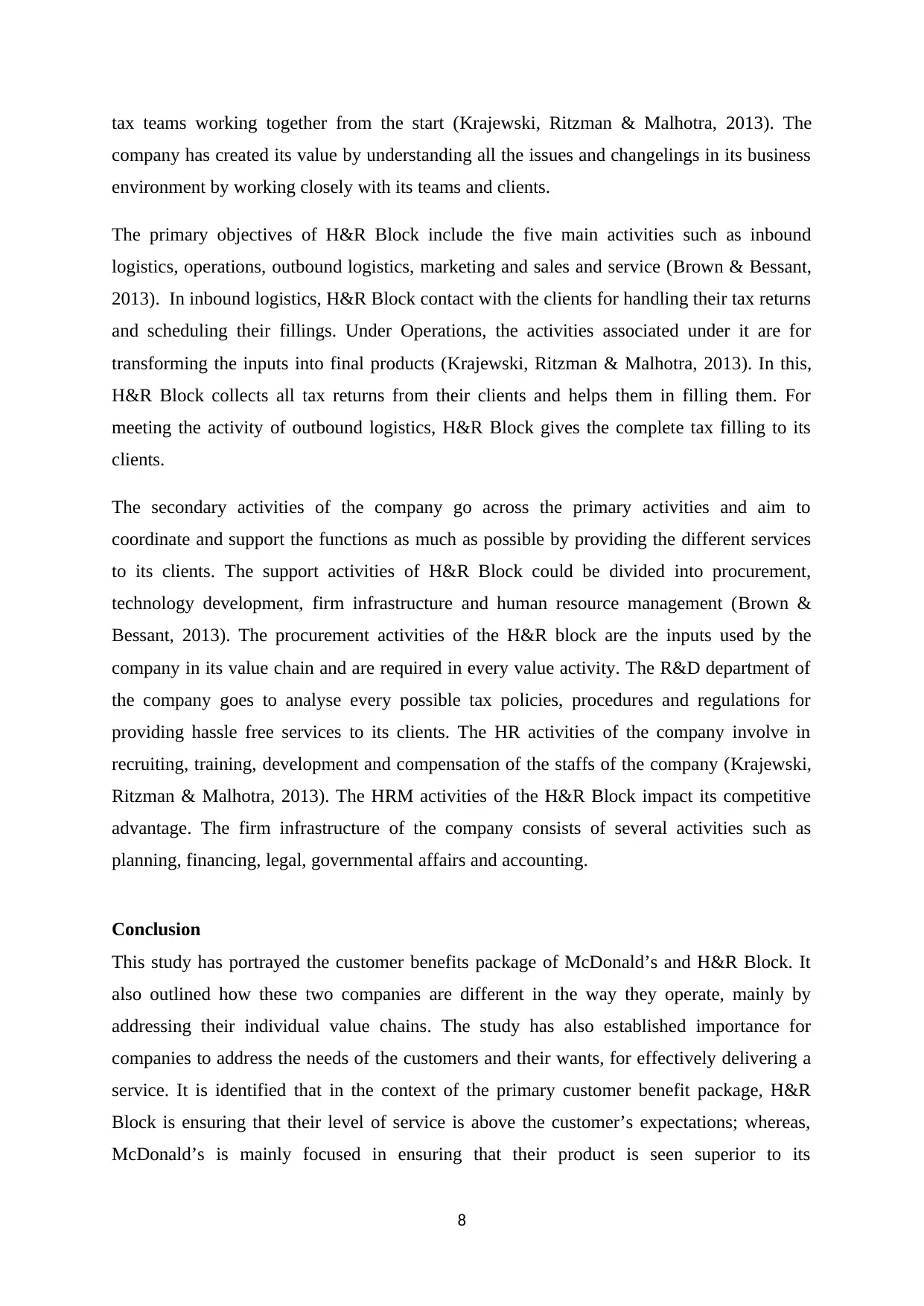
tax teams working together from the start (Krajewski, Ritzman & Malhotra, 2013). The
company has created its value by understanding all the issues and changelings in its business
environment by working closely with its teams and clients.
The primary objectives of H&R Block include the five main activities such as inbound
logistics, operations, outbound logistics, marketing and sales and service (Brown & Bessant,
2013). In inbound logistics, H&R Block contact with the clients for handling their tax returns
and scheduling their fillings. Under Operations, the activities associated under it are for
transforming the inputs into final products (Krajewski, Ritzman & Malhotra, 2013). In this,
H&R Block collects all tax returns from their clients and helps them in filling them. For
meeting the activity of outbound logistics, H&R Block gives the complete tax filling to its
clients.
The secondary activities of the company go across the primary activities and aim to
coordinate and support the functions as much as possible by providing the different services
to its clients. The support activities of H&R Block could be divided into procurement,
technology development, firm infrastructure and human resource management (Brown &
Bessant, 2013). The procurement activities of the H&R block are the inputs used by the
company in its value chain and are required in every value activity. The R&D department of
the company goes to analyse every possible tax policies, procedures and regulations for
providing hassle free services to its clients. The HR activities of the company involve in
recruiting, training, development and compensation of the staffs of the company (Krajewski,
Ritzman & Malhotra, 2013). The HRM activities of the H&R Block impact its competitive
advantage. The firm infrastructure of the company consists of several activities such as
planning, financing, legal, governmental affairs and accounting.
Conclusion
This study has portrayed the customer benefits package of McDonald’s and H&R Block. It
also outlined how these two companies are different in the way they operate, mainly by
addressing their individual value chains. The study has also established importance for
companies to address the needs of the customers and their wants, for effectively delivering a
service. It is identified that in the context of the primary customer benefit package, H&R
Block is ensuring that their level of service is above the customer’s expectations; whereas,
McDonald’s is mainly focused in ensuring that their product is seen superior to its
8
company has created its value by understanding all the issues and changelings in its business
environment by working closely with its teams and clients.
The primary objectives of H&R Block include the five main activities such as inbound
logistics, operations, outbound logistics, marketing and sales and service (Brown & Bessant,
2013). In inbound logistics, H&R Block contact with the clients for handling their tax returns
and scheduling their fillings. Under Operations, the activities associated under it are for
transforming the inputs into final products (Krajewski, Ritzman & Malhotra, 2013). In this,
H&R Block collects all tax returns from their clients and helps them in filling them. For
meeting the activity of outbound logistics, H&R Block gives the complete tax filling to its
clients.
The secondary activities of the company go across the primary activities and aim to
coordinate and support the functions as much as possible by providing the different services
to its clients. The support activities of H&R Block could be divided into procurement,
technology development, firm infrastructure and human resource management (Brown &
Bessant, 2013). The procurement activities of the H&R block are the inputs used by the
company in its value chain and are required in every value activity. The R&D department of
the company goes to analyse every possible tax policies, procedures and regulations for
providing hassle free services to its clients. The HR activities of the company involve in
recruiting, training, development and compensation of the staffs of the company (Krajewski,
Ritzman & Malhotra, 2013). The HRM activities of the H&R Block impact its competitive
advantage. The firm infrastructure of the company consists of several activities such as
planning, financing, legal, governmental affairs and accounting.
Conclusion
This study has portrayed the customer benefits package of McDonald’s and H&R Block. It
also outlined how these two companies are different in the way they operate, mainly by
addressing their individual value chains. The study has also established importance for
companies to address the needs of the customers and their wants, for effectively delivering a
service. It is identified that in the context of the primary customer benefit package, H&R
Block is ensuring that their level of service is above the customer’s expectations; whereas,
McDonald’s is mainly focused in ensuring that their product is seen superior to its
8
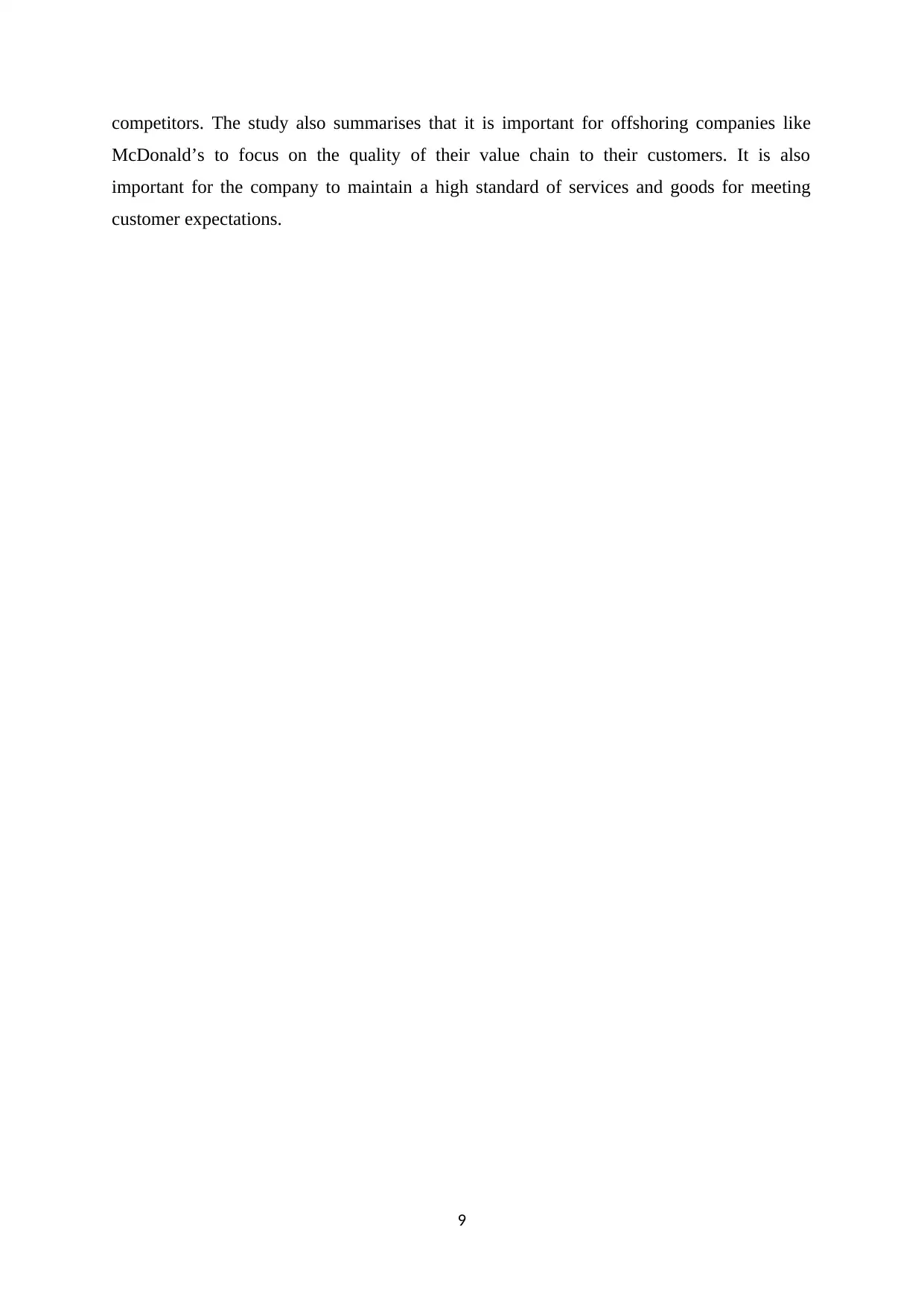
competitors. The study also summarises that it is important for offshoring companies like
McDonald’s to focus on the quality of their value chain to their customers. It is also
important for the company to maintain a high standard of services and goods for meeting
customer expectations.
9
McDonald’s to focus on the quality of their value chain to their customers. It is also
important for the company to maintain a high standard of services and goods for meeting
customer expectations.
9
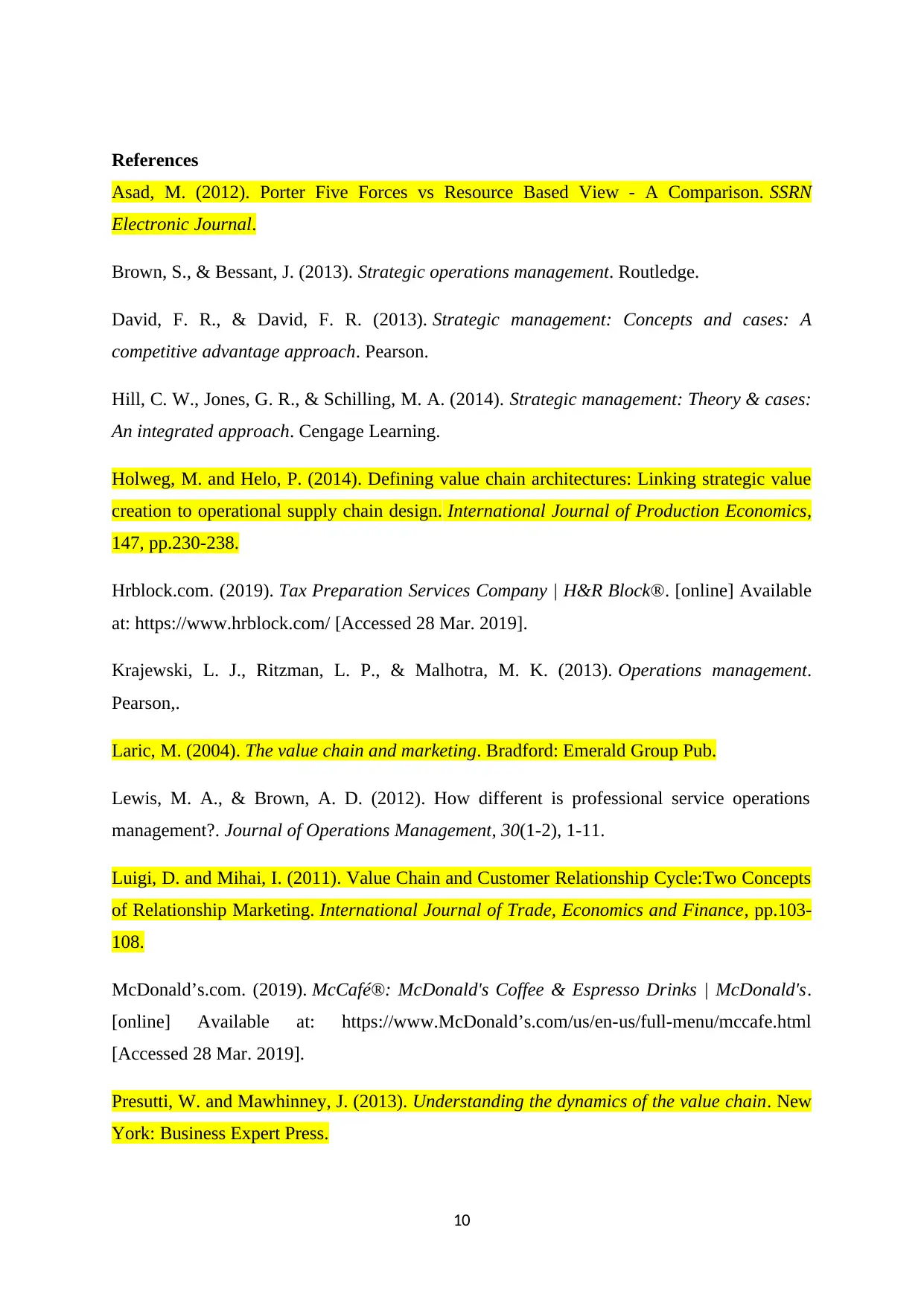
References
Asad, M. (2012). Porter Five Forces vs Resource Based View - A Comparison. SSRN
Electronic Journal.
Brown, S., & Bessant, J. (2013). Strategic operations management. Routledge.
David, F. R., & David, F. R. (2013). Strategic management: Concepts and cases: A
competitive advantage approach. Pearson.
Hill, C. W., Jones, G. R., & Schilling, M. A. (2014). Strategic management: Theory & cases:
An integrated approach. Cengage Learning.
Holweg, M. and Helo, P. (2014). Defining value chain architectures: Linking strategic value
creation to operational supply chain design. International Journal of Production Economics,
147, pp.230-238.
Hrblock.com. (2019). Tax Preparation Services Company | H&R Block®. [online] Available
at: https://www.hrblock.com/ [Accessed 28 Mar. 2019].
Krajewski, L. J., Ritzman, L. P., & Malhotra, M. K. (2013). Operations management.
Pearson,.
Laric, M. (2004). The value chain and marketing. Bradford: Emerald Group Pub.
Lewis, M. A., & Brown, A. D. (2012). How different is professional service operations
management?. Journal of Operations Management, 30(1-2), 1-11.
Luigi, D. and Mihai, I. (2011). Value Chain and Customer Relationship Cycle:Two Concepts
of Relationship Marketing. International Journal of Trade, Economics and Finance, pp.103-
108.
McDonald’s.com. (2019). McCafé®: McDonald's Coffee & Espresso Drinks | McDonald's.
[online] Available at: https://www.McDonald’s.com/us/en-us/full-menu/mccafe.html
[Accessed 28 Mar. 2019].
Presutti, W. and Mawhinney, J. (2013). Understanding the dynamics of the value chain. New
York: Business Expert Press.
10
Asad, M. (2012). Porter Five Forces vs Resource Based View - A Comparison. SSRN
Electronic Journal.
Brown, S., & Bessant, J. (2013). Strategic operations management. Routledge.
David, F. R., & David, F. R. (2013). Strategic management: Concepts and cases: A
competitive advantage approach. Pearson.
Hill, C. W., Jones, G. R., & Schilling, M. A. (2014). Strategic management: Theory & cases:
An integrated approach. Cengage Learning.
Holweg, M. and Helo, P. (2014). Defining value chain architectures: Linking strategic value
creation to operational supply chain design. International Journal of Production Economics,
147, pp.230-238.
Hrblock.com. (2019). Tax Preparation Services Company | H&R Block®. [online] Available
at: https://www.hrblock.com/ [Accessed 28 Mar. 2019].
Krajewski, L. J., Ritzman, L. P., & Malhotra, M. K. (2013). Operations management.
Pearson,.
Laric, M. (2004). The value chain and marketing. Bradford: Emerald Group Pub.
Lewis, M. A., & Brown, A. D. (2012). How different is professional service operations
management?. Journal of Operations Management, 30(1-2), 1-11.
Luigi, D. and Mihai, I. (2011). Value Chain and Customer Relationship Cycle:Two Concepts
of Relationship Marketing. International Journal of Trade, Economics and Finance, pp.103-
108.
McDonald’s.com. (2019). McCafé®: McDonald's Coffee & Espresso Drinks | McDonald's.
[online] Available at: https://www.McDonald’s.com/us/en-us/full-menu/mccafe.html
[Accessed 28 Mar. 2019].
Presutti, W. and Mawhinney, J. (2013). Understanding the dynamics of the value chain. New
York: Business Expert Press.
10
Secure Best Marks with AI Grader
Need help grading? Try our AI Grader for instant feedback on your assignments.
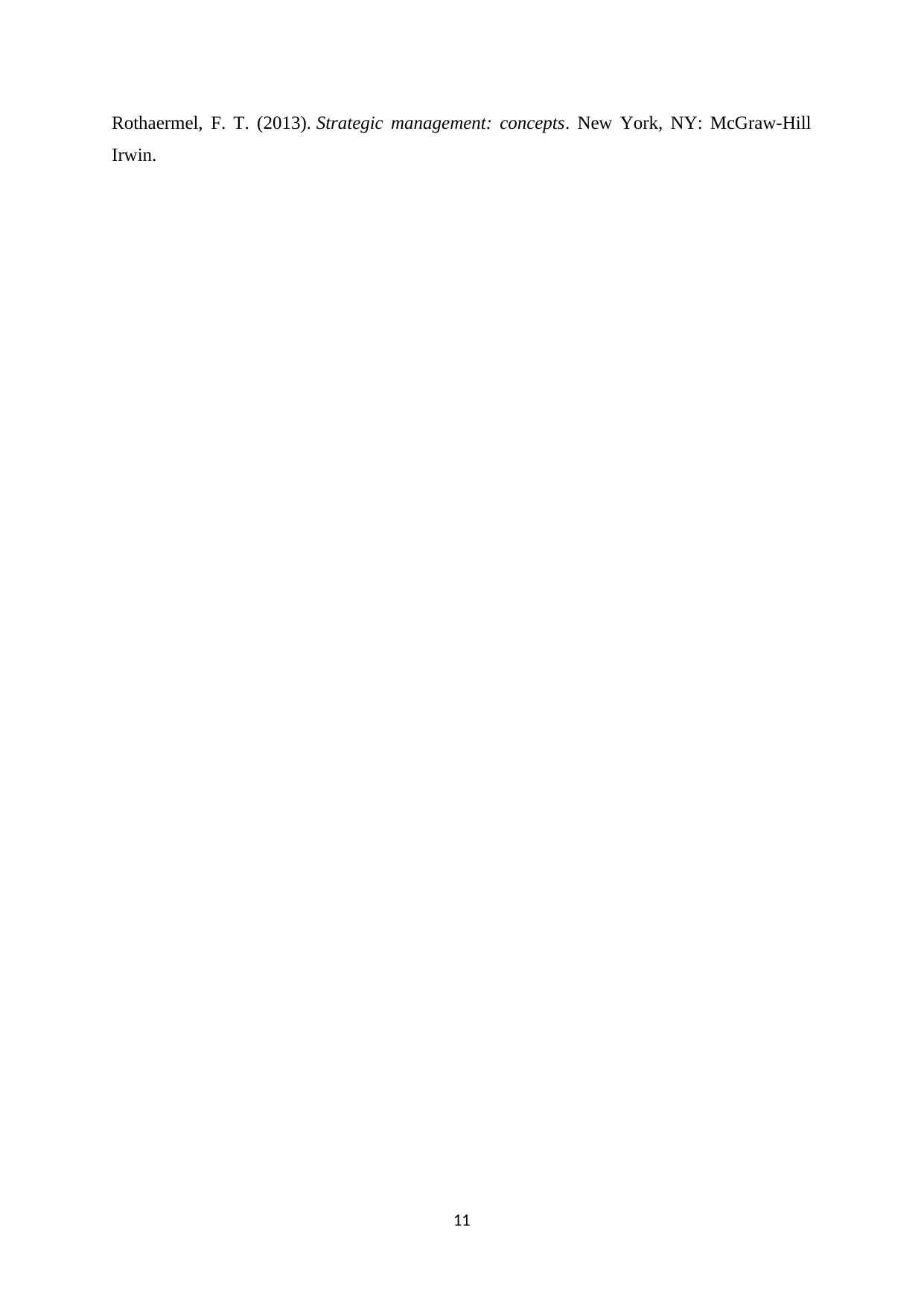
Rothaermel, F. T. (2013). Strategic management: concepts. New York, NY: McGraw-Hill
Irwin.
11
Irwin.
11
1 out of 11
Related Documents
Your All-in-One AI-Powered Toolkit for Academic Success.
+13062052269
info@desklib.com
Available 24*7 on WhatsApp / Email
![[object Object]](/_next/static/media/star-bottom.7253800d.svg)
Unlock your academic potential
© 2024 | Zucol Services PVT LTD | All rights reserved.





